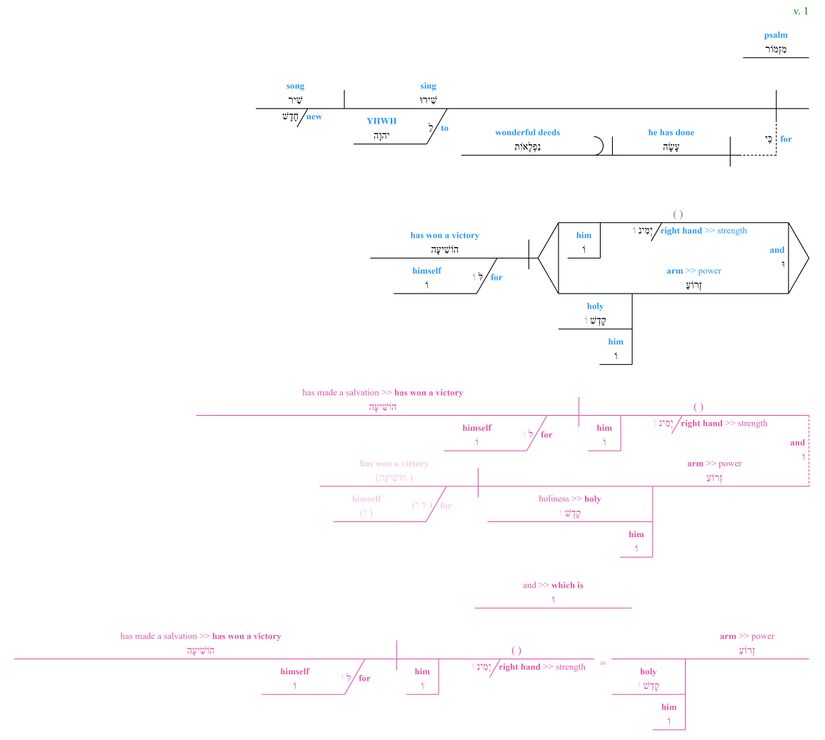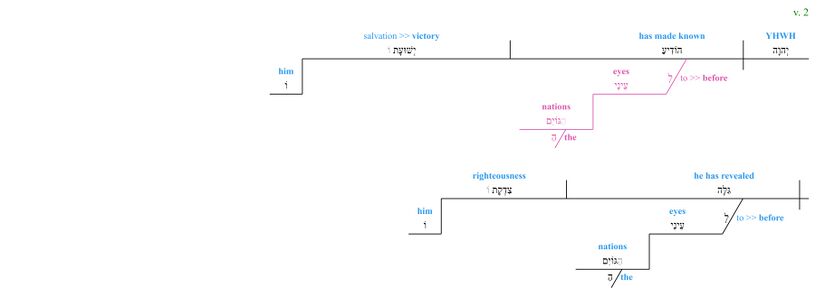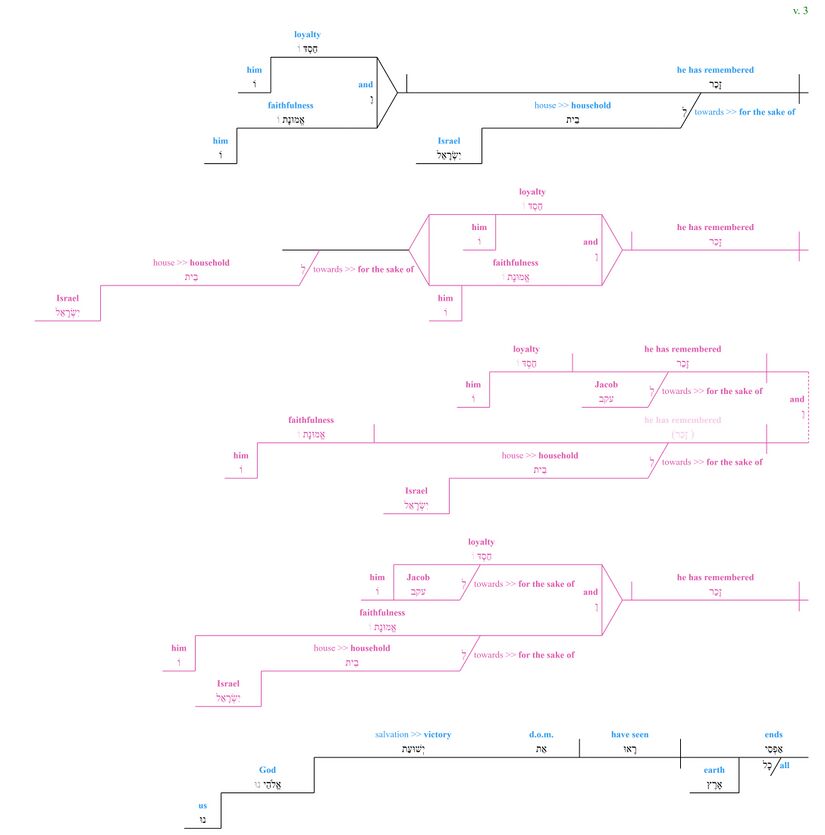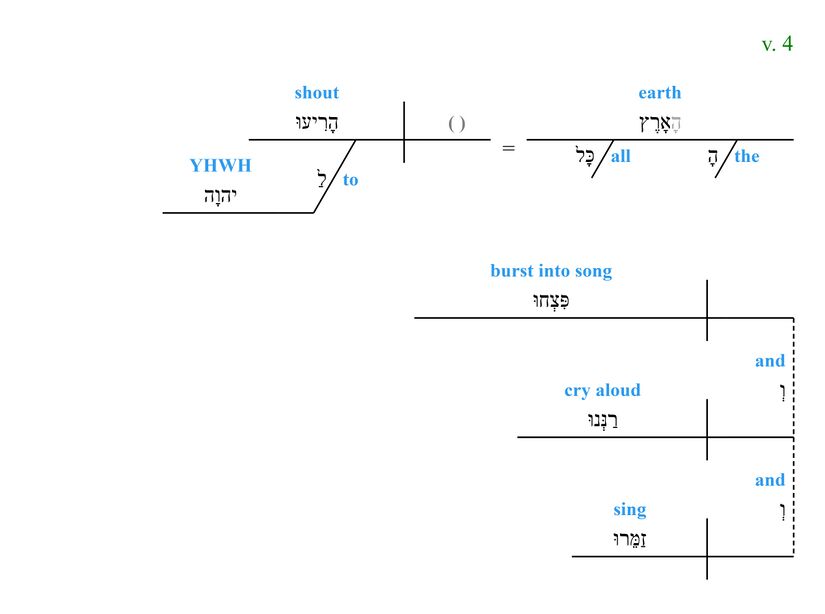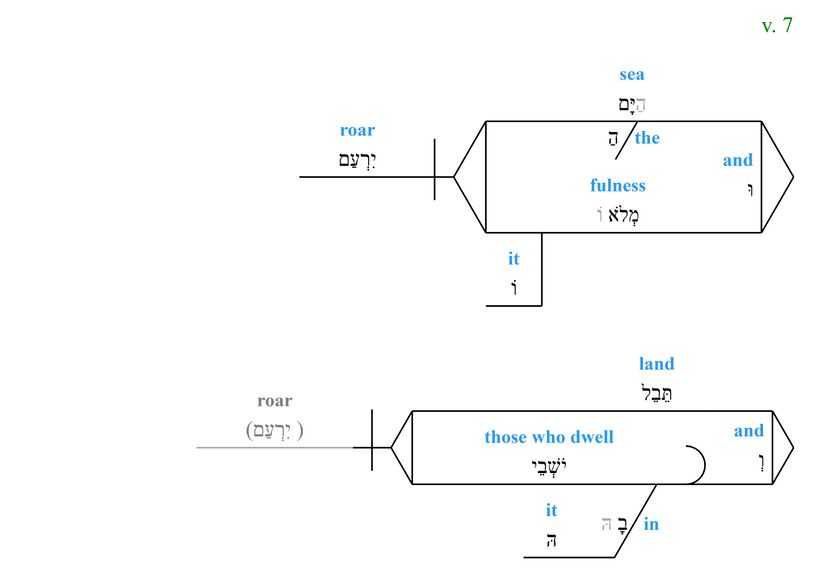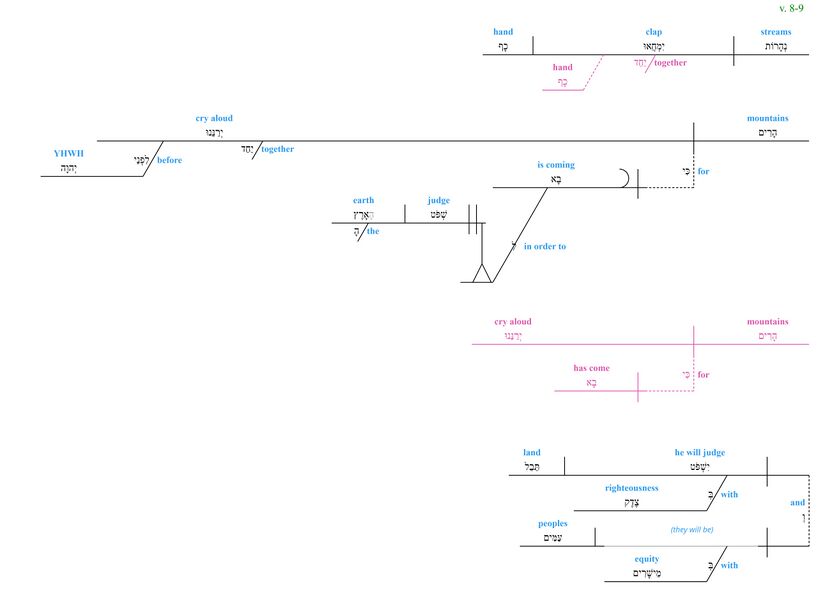Psalm 98 Grammar
About the Grammar Layer
The grammar layer visually represents the grammar and syntax of each clause. It also displays alternative interpretations of the grammar. (For more information, click "Expand" to the right.)
The grammatical diagram provides a way to visualise how different parts of a sentence work together. It represents the “surface-level” grammar, or morphosyntax, of a sentence. Morphosyntax includes both the form of words (morphology) and their placement in the sentence (syntax). This approach to visualising the text, based on the Reed-Kellogg diagramming method, places the grammatical subject in one slot, the verb in another slot, and modifiers and connectives in other slots.
For a detailed description of our method, see the Grammar Creator Guidelines.
Grammar Visuals for Psalm 98
| Visualization | Description |
|---|---|
| The clause is represented by a horizontal line with a vertical line crossing through it, separating the subject and the verb. | |
| The object is indicated by a vertical line that does not cross the horizontal line of the clause. Infinitives and participles may also have objects. If the direct object marker (d.o.m.) is present in the text, it appears in the diagram immediately before the object. If the grammar includes a secondary object, the secondary object will appear after the object, separated by another vertical line that does not cross the horizontal line of the clause. | |
| The subject complement follows the verb (often omitted in Hebrew) separated with a line leaning toward the right. It can be a noun, a whole prepositional phrase or an adjective. The later two appear modifying the complement slot. | |
| When a noun further describes or renames the object, it is an object complement. The object complement follows the object separated by a line leaning toward the right. | |
| In a construct chain, the noun in the absolute form modifies the noun in the construct form. | |
| Participles are indicated in whatever position in the clause they are in with a curved line before the participle. Participles can occur as nominal, where they take the place of a noun, predicate, where they take the place of a verb, or attributive, where they modify a noun or a verb similar to adjectives or adverbs. | |
| Infinitives are indicated by two parallel lines before the infinitive that cross the horizontal line. Infinitive constructs can appear as the verb in an embedded clause. Infinitive absolutes typically appear as an adverbial. | |
| The subject of the infinitive often appears in construct to it. In this situation, the infinitive and subject are diagrammed as a construct chain. | |
| The object of the infinitive is indicated by a vertical line that does not cross the horizontal line of the infinitival clause. | |
| Modifiers are represented by a solid diagonal line from the word they modify. They can attach to verbs, adjectives, or nouns. If modifying a verb or adjective, it is an adverb, but if modifying a noun, it is an adjective, a quantifier, or a definite article. If an adverb is modifying a modifier, it is connected to the modifier by a small dashed horizontal line. | |
| Adverbials are indicated by a dashed diagonal line extending to a horizontal line. These are nouns or infinitives that function adverbially (modifying either a verb or a participle), but are not connected by a preposition. | |
| Prepositional phrases are indicated by a solid diagonal line extending to a horizontal line. The preposition is to the left of the diagonal line and the dependent of the preposition is on the horizontal line. They can modify verbs (adverbial) or nouns (adjectival). | |
| Embedded clauses are indicated by a "stand" that looks like an upside-down Y. The stand rests in the grammatical position that the clause fulfills. Extending from the top of the stand is a horizontal line for the clause. If introduced by a complementizer, for example כִּי, the complementizer appears before the stand. Embedded clauses can stand in the place of any noun. | |
| When clauses are joined by a conjunction, they are compound clauses. These clauses are connected by a vertical dotted line. The conjunction is placed next to the dotted line. | |
| Within a clause, if two or more parts of speech are compound, these are represented by angled lines reaching to the two compound elements connected by a solid vertical line. If a conjunction is used, the conjunction appears to the left of the vertical line. Almost all parts of speech can be compound. | |
| Subordinate clauses are indicated by a dashed line coming from the line dividing the subject from the predicate in the independent clause and leading to the horizontal line of the subordinate clause. The subordinating conjunction appears next to the dashed line. | |
| Relative clauses also have a dashed line, but the line connects the antecedent to the horizontal line of the relative clause. The relative particle appears next to the dashed line. | |
| Sentence fragments are represented by a horizontal line with no vertical lines. They are most frequently used in superscriptions to psalms. They are visually similar to discourse particles and vocatives, but most often consist of a noun phrase (that does not refer to a person or people group) or a prepositional phrase. | |
| In the body of the psalm, a horizontal line by itself (with no modifiers or vertical lines) can indicate either a discourse particle or a vocative (if the word is a noun referring to a person or people group). A discourse particle is a conjunction or particle that functions at the discourse level, not at the grammatical level. Vocatives can appear either before or after the clause addressed to them, depending on the word order of the Hebrew. | |
| Apposition is indicated by an equal sign equating the two noun phrases. This can occur with a noun in any function in a sentence. |
| Hebrew text colors | |
|---|---|
| Default preferred text | The default preferred reading is represented by a black line. The text of the MT is represented in bold black text. |
| Dispreferred reading | The dispreferred reading is an alternative interpretation of the grammar, represented by a pink line. The text of the MT is represented in bold pink text, while emendations and revocalizations retain their corresponding colors (see below). |
| Emended text | Emended text, text in which the consonants differ from the consonants of the Masoretic text, is represented by bold blue text, whether that reading is preferred or dispreferred. |
| Revocalized text | Revocalized text, text in which only the vowels differ from the vowels of the Masoretic text, is represented by bold purple text, whether that reading is preferred or dispreferred. |
| (Supplied elided element) | Any element that is elided in the Hebrew text is represented by bold gray text in parentheses. |
| ( ) | The position of a non-supplied elided element is represented by empty black parentheses. For example, this would be used in the place of the noun when an adjective functions substantivally or in the place of the antecedent when a relative clause has an implied antecedent. |
| Gloss text colors | |
|---|---|
| Gloss used in the CBC | The gloss used in the Close-but-Clear translation is represented by bold blue text. |
| Literal gloss >> derived meaning | A gloss that shows the more literal meaning as well as the derived figurative meaning is represented in blue text with arrows pointing towards the more figurative meaning. The gloss used in the CBC will be bolded. |
| Supplied elided element | The gloss for a supplied elided element is represented in bold gray text. |
v. 1
- Note: Alternatives for verse 1 regarding the function of the conjunction waw.
- Although we have diagrammed the second half of verse 1 with three options, there are actually more. The verb is feminine singular, and we must ask ourselves at what level is the waw linking "right hand" and "arm" operating. This difficulty is visible in the multiple ways different modern translations read.
- 1) The waw is conjoining "arm" and "right hand" at the phrasal level. Many modern versions simply translate the verb as plural with a compound subject (ESV or NET, for example). This may be justified by the principle of partial agreement in Biblical Hebrew, which stipulates that in a verb-compound subject construction, grammatical agreement happens between the verb and the first member of the compound subject. After studying the subject of partial agreement in Biblical Hebrew, Scheumann affirms that, "Within VS clauses, the verb is rarely plural when the verb and compound subject are contiguous (9%). When, however, the compound subject is non-contiguous to the verb, the verb actually tends to be plural (55.6%)" (Scheumann 2021: 13). We have taken this as our preferred option because the verb ישׁע is 3rd feminine singular in agreement with יָמִין (for its feminine gender, see, e.g., Ps 21:9), the first part of the compound subject.
- 2) The waw operates at the clausal level in such as way that we actually have two clauses with the verb elided in the second. I have not seen many modern versions taking this position, other than the NLT.
- 3) The waw is actually creating an apposition between "arm" and "right hand." A few modern versions go with this view, like JPS 1985 which has "His right hand, His holy arm, has won Him victory". Gesenius classifies this type of waw as explicativum. He says that "Frequently wāw copulativum is also explanatory (like isque, et—quidem, and the German und zwar, English to wit), and is then called wāw explicativum, e.g. Gn 4.4 and (i.e. namely) of the fat thereof (unless it is simply copulative); Ex 24.12, 25:12 (to wit two); 27:14, 28:23, Ju 17:3 (in וּמַסֵּכָה; here as often elsewhere, to introduce an explanatory gloss, cf. Is 17:8, Ez 31:5, and especially P. Haupt, SBOT. Isaiah, p. 90, l. 21 ff.), 1 S 17:34 and that too with the bear; 2 S 13:20, Is 57:11, Jer 17:10, Am 3:11, 4:10, Ze 9:9, Pr 3:12, Neh 8:13, 2 Ch 23:10 (but in 1 S 28:3 the וּ before בְּעִירוֹ is to be omitted with the LXX); cf. also such combinations as וְעַד—מִן from... and even to..., Gn 13:3, 14:23, 19:4, 11, &c.—In 1 S 6:11 (see Driver on the passage), 2 S 1:23, &c., ו is equivalent to yea, and; in Is 3:27 even. וְ is used to express emphasis (=and especially), e.g. in Gn 3:16 וְהֵֽרֹנֵךְ; Is 2:1, ψ 18:1, perhaps also in Jb 10:17 yea, a whole host; 2 Ch 16:14" (GKC §154).
- 4) Some modern versions have a fourth position that might not be relevant for our question. Those versions make God the subject of the verb and translate "arm" and "right hand" as instruments used by God to accomplish the victory, thus "by his arm and his right hand, he has..." (cf. CEV). Because this reading is more of a paraphrase, we have not included it in the diagram as an alternative construction of the Hebrew grammar.
v. 2
- Note on the alternative reading of verse 2: The prepositional phrase is seen by many versions as modifying the second clause, rather than the first. We have also preferred this alternative based on the poetry of the verse. This alternative offers a more balanced colas. More is said at the layer of the poetics.
v. 3
- Notes on alternatives of verse 3: There are four possibilities for the first part of the verse depending on three issues: (a) the emendation of the prepositional phrase "to Jacob" as visible in some ancient witness like the LXX; (b) the position of the prepositional phrases; and (c) the level at which the waw operates.
- Option 1: One prepositional phrase modifies the verb "remember" (preferred). This option does not read "to Jacob" but simply follows the MT text. In this case, "for the house of Israel" indicates the beneficiary of YHWH's remembrance, rather than indicating the object of his faithfulness and loyalty. Here YHWH remembers (in favor of Israel) his faithfulness and loyalty (for the common Hebrew idiom, see Jenni 2000: 129; cf. GNT). The waw operates at the nominal phrase level.
- Option 2: The prepositional phrase "to the house of Israel" modifies the direct objects of the verb "remember." In this situation, the faithfulness and loyalty are directed towards Israel. This reading does not emend the text in favor of the LXX reading "to Jacob." Here too, the waw operates at the nominal phrase level. Most modern versions position "to the house of Israel" after "his faithfulness and loyalty," following the order of the Hebrew text, which seems to suggest this interpretation. While being "faithful to (someone)" is a common English expression, אמונה ל־ is never attested in Classical Hebrew with this sense (cf. אמונה עם in Ps 89:25; אמונה ב־ in 1QpHab 8.2-3).
- Option 3: We emend the text in favor of the LXX reading, and the prepositional phrase "to Jacob" modifies the verb "remember." We have two clauses with the verb being elided in the second clause, where the implied verb "remember" is modified by the prepositional phrase "for the house of Israel." The waw functions at the clausal level.
- Option 4: The text is emended to the LXX reading. There is one clause with a compound direct object, with each noun modified by its respective prepositional phrase, "to Jacob" and " to Israel." The waw operates at the phrasal level.
v. 4
v. 5
v. 6
v. 7
vv. 8-9
- Alternatives with כף:
- Option 1: כף functions as the direct object of the verb מָחָא.
- Option 2: כף functions adverbially and modifies the main verb מָחָא.
- Even though syntactically we have two options, the meaning remains the same, namely "to clap hands." SDBH remarks that the verb is an "action by which humans strike the palms of their hands together repeatedly" in three passages: Ps 98:8, Isa 55:12, and Ezek 25:6. In the latter two passages, the verb is connected with "hand" or "palm" in the singular but lacking "יחד".
- Alternatives with יחד:
- Option 1: יחד functions adverbially and modifies the verb מָחָא (LXX, ISV). In this reading, the streams are clapping together, in one accord. We disfavor this option because of the poetry which is less balanced metrically speaking. More is said here at the poetic layer.
- Option 2: יחד functions adverbially and modifies the verb רָנַן (most versions). In this option, יחד operates not with the first clause but with the second clause with the main verb רנן. This means that the mountains are shouting together. The best support against this option is poetic, since v. 8 is not well balanced poetically when יחד treated as part of v. 8b. More is said about this poetic symmetry at the poetic layer .
- Although the phrase לִפְנֵי־יְהוָה is placed in the MT in verse 9, we have joined it to the final clause of v. 8 with many versions like the ESV and NIV. This may be explained semantically, because the phrase fits only very awkwardly in the syntax of v. 9, but makes perfect sense attached to the verb "sing" of v. 8 (Bratcher and Reyburn 1991: 847). It is also worth noting that the LXX omits the phrase לִפְנֵי־יְהוָה, unlike in the parallel passages of Ps 96:13 and 1 Chr 16:33. Although the adverbial phrase fits well the poetry of the verse (more on this is given at the poetic layer), this absence suggests that the phrase לִפְנֵי־יְהוָה was a later scribal addition that assimilates Ps. 98:9 to its parallel in 96:13, which also explains the syntactical difficulty of the phrase. Nonetheless, several old witnesses support the MT. Symmachus and Theodotion include the prepositional phrase, as do the Peshitta (ܫܒܚܘ ܠܡܪܝܐ "before the Lord") and the Psalms Targum (קדם ייי "before YHWH"). We have thus preferred this reading.




















